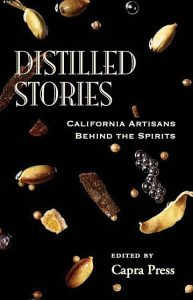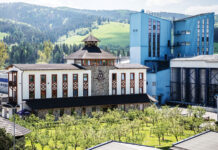Distilled Stories: California Artisans Behind the Spirits
Edited by Capra Press, 2016
Softcover/256 pages
ISBN 978-1592661060
$20.00
Distilled Stories: California Artisans Behind the Spirits (edited by Capra Press) recounts the stories of 32 California distillers and how they came to make distilling their profession. Distilled Stories was born out of a desire to better understand the spirits renaissance that is currently sweeping much of the world. After a chance meeting with Arthur Hartunian, the editors of the book decided to seek out and interview members of the California Artisanal Distillers Guild to hear their stories and record for posterity what inspired their passion for distilling and drove them to make it their life’s work. Distilled Stories is introduced by Wayne Curtis with a brief history of the U.S. spirits industry, which sets the distillers’ stories into their proper historical context.
In Wayne Curtis’s introduction, he likens the growth and increased variety of high-quality spirits available to consumers to a child’s coloring box which once only held six colors but now contains 128. Similarly, each distiller’s story represents the addition of a new hue to the spirits world that is making it more rich and vibrant than ever before. Distilled Stories is a fascinating and interesting read because each distiller’s story is unique and varied. Some of the distillers come from long family traditions that span hundreds of years, while others are completely new to the industry. Despite these variations in background, each distiller’s story illustrates the drive and passion it takes to create unique spirits that they and their families can be proud of. Each story also represents a part of the vanguard of California’s burgeoning artisan distilling movement. While it is certain that the number of California distilleries will continue to grow, Distilled Stories will serve as an important artifact for spirit lovers and inspiration for future generations of distillers. EZ
The Artisan’s Guide to Crafting Distilled Spirits: Small-Scale Production of Brandies, Schnapps & Liquors
Bettina Malle and Helge Schmickl translated by Paul Lehmann
Austin: Spikehorn Press, 2015
Softcover/200 pages
ISBN 978-1943015047
$29.95
The authors of The Artisan’s Guide to Crafting Distilled Spirits, Bettina Malle and Helge Schmickl, both have doctorates in technical sciences and chemical engineering. In 1998, they designed their first still and began teaching workshops on distilling in Austria. In 2003, they published a book, based on their experiments in distilling a variety of fruit brandies and infusing liquors, called
Schnaps brennen als Hobby. Since then, they have also written two books about making essential oils and vinegar.
The Artisan’s Guide to Crafting Distilled Spirits is an introductory work on distilling, primarily written for non-professional distillers. In the German-speaking countries of Europe, home distilling is permissible with certain licenses and under certain circumstances. Because of this, Malle and Schmickl’s description of distilling, its history and practice are very basic and not well-suited to professionals or even would-be professionals.
The book does not engage deeply with traditional distillation practices, and in some cases the authors make unorthodox claims regarding production techniques that, despite their technical backgrounds, they do not go on to substantiate with science. For this reason the book largely comes across as a reaction to bad home-distilling practices. If Malle and Schmickl had used their expertise to explain why certain traditional techniques work, or made a better case for why their methods produced superior spirits, perhaps all distillers could have benefited.
Ultimately, The Artisan’s Guide to Crafting Distilled Spirits does not fully acknowledge that the best distilled spirits are the result of both artistry and chemistry. The goal of the book is to help its readers make better spirits and to understand some of the chemical processes involved, but at 200 pages, the book is too short to be a thorough technical description of how to craft excellent spirits. Because Malle and Schmickl ignore many of the tried-and-true techniques of traditional distillation and seem to believe that making excellent spirits is instead a matter of following a recipe, Crafting Distilled Spirits is not recommended reading for the professional. EZ










